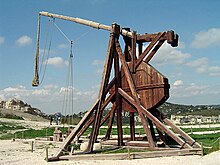In physics, potential energy is the energy of a body or a system with respect to the position of the body or the arrangement of the particles of the system. The SI unit of measure for energy and work is the Joule (symbol J). The term "potential energy" was coined by the 19th century Scottish engineer and physicist William Rankine.
Gravitational energy is the potential energy associated with gravitational force. If an object falls from one point to another point inside a gravitational field, the force of gravity will do positive work on the object, and the gravitational potential energy will decrease by the same amount.
Consider a book placed on top of a table. As the book is raised from the floor, to the table, some external force works against the gravitational force. If the book falls back to the floor, the "falling" energy the book receives is provided by the gravitational force. Thus, if the book falls off the table, this potential energy goes to accelerate the mass of the book and is converted into kinetic energy. When the book hits the floor this kinetic energy is converted into heat and sound by the impact.
The factors that affect an object's gravitational potential energy are its height relative to some reference point, its mass, and the strength of the gravitational field it is in. Thus, a book lying on a table has less gravitational potential energy than the same book on top of a taller cupboard, and less gravitational potential energy than a heavier book lying on the same table. An object at a certain height above the Moon's surface has less gravitational potential energy than at the same height above the Earth's surface because the Moon's gravity is weaker. Note that "height" in the common sense of the term cannot be used for gravitational potential energy calculations when gravity is not assumed to be a constant.











0 comments:
Post a Comment